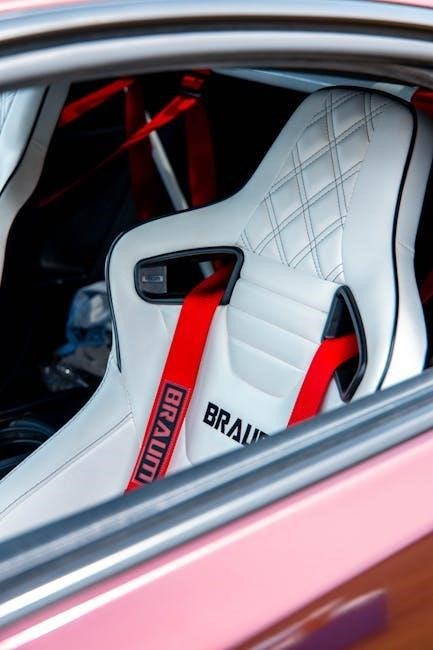Proper installation and use of Safety 1st car seats are crucial for ensuring your child’s safety. These instructions provide step-by-step guidance for correct installation and maintenance.
Overview of the Importance of Proper Car Seat Installation
Proper car seat installation is critical to ensuring your child’s safety while traveling. Incorrect installation can lead to serious risks, including increased injury potential in the event of an accident. Safety 1st car seats are designed to protect your child, but only when installed correctly. Following the manufacturer’s instructions ensures the seat functions as intended, providing optimal protection. Proper installation also prevents the seat from moving excessively, reducing the risk of injury. Always refer to your vehicle’s manual and the car seat’s guidelines for a secure and safe setup. This guide provides detailed steps to help you install your Safety 1st car seat correctly.

Understanding Vehicle Compatibility
Vehicle compatibility is essential for safe car seat installation. Always check your vehicle’s manual for specific requirements and ensure the Safety 1st seat fits securely.
How to Check Your Vehicle’s Compatibility with Safety 1st Car Seats
To ensure compatibility, start by consulting your vehicle’s owner’s manual, focusing on the car seat installation section. Familiarize yourself with the specific requirements for your vehicle, such as the location of LATCH anchors or seatbelt types. Next, review the Safety 1st car seat manual to understand its installation options, including LATCH or seatbelt methods. Check if your vehicle has the necessary features, like lower anchors or tether points, and verify the weight and size limits. If your vehicle lacks LATCH anchors, ensure it has a lap or shoulder belt suitable for seatbelt installation. Additionally, some Safety 1st models may require specific vehicle seating positions, such as rear or forward-facing preferences. Always test the seat in your vehicle to ensure a secure fit before finalizing the installation. Proper compatibility ensures your child’s safety and compliance with both vehicle and car seat regulations.

Choosing the Right Safety 1st Car Seat
Selecting the appropriate Safety 1st car seat involves considering your child’s age, weight, and height. Ensure the seat meets federal safety standards for their size.
Convertible vs. 3-in-1 Car Seats: Which is Best for Your Needs
Convertible car seats transition from rear-facing to forward-facing, offering extended use. The 3-in-1 models add a booster stage, making them more versatile. Choose based on your child’s growth needs.
Installation Steps for Safety 1st Convertible Car Seat
Start by reading your vehicle’s manual. Choose the correct seating position and secure the base using LATCH anchors or a seatbelt for stability and safety.
Step-by-Step Guide for Correct Installation
Read Manuals: Start with your vehicle and car seat manuals to understand specific requirements.
Choose Position: Select a suitable seating position, prioritizing the backseat and middle position for optimal safety.
Secure Base: Use LATCH anchors or a seatbelt to install the base, ensuring it is tightly fastened.
Level the Base: Adjust the base to ensure it is level with your vehicle’s seat.
Tighten Seatbelt/LATCH: Pull the seatbelt or LATCH straps to secure the base firmly.
Install Car Seat: Attach the car seat to the base, ensuring it clicks into place.
Test Stability: Shake the car seat gently to ensure it doesn’t move more than an inch side to side or front to back.
Secure Child: Place your child in the seat, ensuring harness straps are snug and chest clip is at armpit level.
By following these steps, you’ll ensure a safe and proper installation for your child’s Safety 1st car seat.
Using LATCH Anchors vs; Seatbelt Installation Methods
LATCH (Lower Anchors and Tethers for Children) anchors provide a convenient and secure way to install car seats without using a seatbelt. Simply attach the car seat’s connectors to the vehicle’s LATCH anchors and tighten. This method is often easier and reduces the risk of incorrect installation. Alternatively, seatbelt installation is a reliable option, especially for vehicles without LATCH anchors. Thread the seatbelt through the designated path on the car seat and tighten firmly. Both methods ensure safety if done correctly, but LATCH is generally more straightforward for many parents. Always consult your vehicle and car seat manuals for specific guidance.
Securing Your Child in the Safety 1st Car Seat
Ensure your child’s harness is snug, with the chest clip at armpit level. Adjust the seat as your child grows to maintain proper fit and safety.
Proper Harness Tightening Techniques
Properly tightening the harness is essential for your child’s safety. Start by buckling your child and ensuring the straps are flat and untwisted. Tighten the harness until it fits snugly against your child’s body. The chest clip should be positioned at armpit level to ensure proper restraint. Perform the pinch test: if you can pinch any fabric, the harness needs to be tightened further. Regularly check and adjust the harness as your child grows. Always ensure the harness is secure before each trip to provide optimal protection.
Adjusting the Seat as Your Child Grows
As your child grows, it’s crucial to adjust the Safety 1st car seat to ensure proper fit and safety. Regularly check the harness height, ensuring it aligns with your child’s shoulders. For rear-facing, the harness should be at or below shoulder level, while forward-facing requires it to be at or above. Adjust the seat’s headrest and shoulder straps accordingly. If using a convertible or 3-in-1 seat, refer to the manual for guidance on transitioning between modes. Always tighten the base securely after adjustments and verify the seat’s stability. Proper adjustments ensure your child’s continued safety and comfort;

Maintenance and Upkeep of the Car Seat
Regularly inspect the car seat for wear and tear, clean it with gentle detergents, and store it in a cool, dry place. Always follow the manufacturer’s guide for proper upkeep to ensure longevity and safety.
Cleaning the Car Seat Safely
To clean the Safety 1st car seat, start by removing any loose debris. Use a mild soap and warm water solution to gently scrub stains or spills. Avoid harsh chemicals or abrasive cleaners, as they may damage the materials. For tough stains, let the solution sit for a few minutes before wiping clean with a soft cloth. Never submerge the seat in water or use a washing machine, as this can harm the structural integrity. Allow the seat to air dry completely before reusing it. Always refer to the user manual for specific cleaning instructions to ensure safety and durability.
Understanding When to Replace the Car Seat
Replace the Safety 1st car seat if it has been involved in a crash, shows signs of wear, or exceeds the expiration date listed in the manual. Most car seats expire after 6-10 years from the manufacture date. Additionally, replace the seat if it no longer fits your child correctly or if it has been recalled. Check for any damage or fraying of straps and ensure all components are functioning properly. Regularly inspect the seat for any degradation, especially in high-heat environments. Always follow the manufacturer’s guidelines to ensure your child’s continued safety and protection.
Recent Safety 1st Car Seat Recalls
Safety 1st recalled 180,000 car seats due to potential choking hazards. Affected models received free repair kits with installation instructions to ensure child safety.
How to Check if Your Car Seat is Affected
To determine if your Safety 1st car seat is part of a recall, locate the model number on the side or base of the seat. Visit the official Safety 1st website or contact their customer service directly. Provide the model number and manufacturing date to check against recall lists. If your seat is affected, follow the provided instructions to obtain a free repair kit, ensuring your child’s continued safety and compliance with regulations.
New Federal Safety Standards for Car Seats
Starting June 30, 2025, new federal safety standards require enhanced side-impact protection in all U.S.-sold car seats, ensuring improved safety for children during collisions.
What You Need to Know About Upcoming Regulations
Starting June 30, 2025, new federal safety standards will require car seats to meet enhanced side-impact protection criteria. These regulations aim to improve child safety during collisions. Manufacturers must adhere to rigorous testing and certification processes. Parents should expect updated installation guidelines and features like improved harness systems. The standards also address ease of use, ensuring safer and more intuitive car seat setups. Staying informed about these changes will help you choose compliant products and maintain your child’s safety on the road.
Additional Safety Features of Safety 1st Car Seats
Safety 1st car seats include advanced features like side-impact protection, reinforced frames, and energy-absorbing materials to enhance child safety in various collision scenarios.
Side-Impact Protection and Other Advanced Features
Safety 1st car seats prioritize side-impact protection with reinforced frames and energy-absorbing materials to minimize collision forces. Advanced features include adjustable headrests for optimal positioning and lightweight designs for ease of use. These seats also incorporate innovative technologies to ensure superior safety and comfort, meeting the latest federal safety standards. By combining durability and cutting-edge engineering, Safety 1st car seats offer unparalleled protection for children in various crash scenarios, giving parents peace of mind on the road.

Troubleshooting Common Installation Issues
- Check for loose connections or improper belt routing.
- Tighten the base firmly to eliminate movement.
- Consult the manual for LATCH anchor limitations.
- Ensure the seat is level for correct positioning.
Resolving Base Installation Problems
Common issues with base installation include improper alignment or loose connections. Ensure the base is tightly secured using LATCH anchors or a seatbelt. If the base moves, check the seatbelt routing and tighten firmly. For rear-facing installations, verify the base is level and stable. If using LATCH, ensure anchors are correctly positioned and not overloaded. For added stability, a pool noodle or rolled towel can support the base. Always refer to the Safety 1st manual for specific guidance tailored to your car seat model, such as the Grow and Go 3-in-1.
Always follow Safety 1st car seat instructions to ensure proper installation and maintenance, crucial for your child’s safety and well-being.
Final Tips for Ensuring Your Child’s Safety
Regularly inspect your Safety 1st car seat for wear or damage. Ensure the harness fits snugly, with the chest clip at armpit level. Always use the seatbelt or LATCH system correctly. Keep your child rear-facing as long as possible. Stay updated on recalls and follow the manufacturer’s instructions for repairs. Avoid adding unapproved accessories. Clean the seat according to guidelines to maintain its integrity. Replace the seat immediately if it’s been in a crash or exceeds its expiration date. Consistent, correct use ensures optimal protection for your child.
Further Reading and Resources
For more detailed guidance, visit the Safety 1st official website, which offers comprehensive user manuals, installation videos, and troubleshooting tips. Additionally, consult resources like the National Highway Traffic Safety Administration (NHTSA) for car seat safety standards and recalls. Local car seat inspection stations can also provide hands-on assistance. Stay informed about product updates and safety advisories by subscribing to Safety 1st newsletters or following their customer support channels. These resources ensure you stay up-to-date and well-equipped to keep your child safe on the road.


